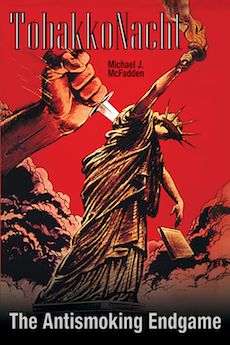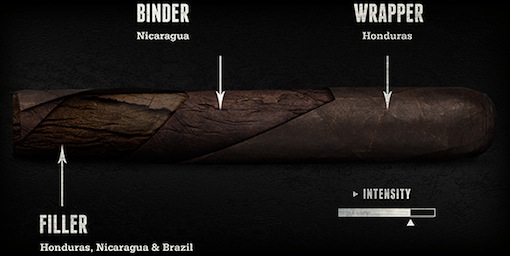[Editor’s Note: See the end of today’s article to learn how to win a free copy of this book.]
Michael J. McFadden’s new book, TobakkoNacht: The Antismoking Endgame, is an in-depth, carefully documented exploration of how tobacco opponents work. With an Ivy League education and no financial interest in tobacco, McFadden presents technical material in an engaging and understandable format, mixing humor, statistics, anecdote, stories, and surprises. We recently exchanged emails for the following [edited] interview.
 Stogie Guys: Can you tell us a little about your background and how you got involved in researching and writing about tobacco?
Stogie Guys: Can you tell us a little about your background and how you got involved in researching and writing about tobacco?
Michael J. McFadden: The issue of scientific integrity and telling the truth was always important to me. Seeing people unjustly gain at the expense of other people on the basis of lies always angered me, and it’s something I’ve seen throughout the antismoking movement.
My concern with what drives human conflict and allows people to tolerate the suffering or killing of others goes back to my college years and my Peace Studies program. Yes, thermonuclear war is a much more important issue than a smoking ban at the local bar, but they’re both based on people being led to believe lies that lead them to feel it’s OK to attack some other group of people… a dehumanizing of another group.
I first became aware of and concerned about this issue in 1976 when a housemate showed up at our West Philadelphia nonviolence training center with a fistful of leaflets from ASH that were clearly filled with lies and exaggerations. Those lies split our community and helped to eventually destroy our training center altogether, but I didn’t have the background knowledge to be able to fight them effectively. That was really when I began researching the issue.
SG: Your new book, TobakkoNacht, has a somewhat unusual structure. How would you describe it? And how does it differ from your earlier works?
MM: TobakkoNacht is structured to appeal to and benefit several different audiences simultaneously. It has some sections of very serious and fairly complex material, and others of a more relaxed design for quick reading in small units or in environments where one might be distracted during one’s reading.
It’s a book that a less-serious reader can enjoy jumping around in while benefiting a lot along the way, while a more knowledgeable activist or researcher will still find new perspective and knowledge from sections like the extensive “Studies on the Slab.” The opening story sets an emotional tone that is later justified by the explorations of science, and the closing “Endgame†section wraps it all up and provides suggestions for the future. Finally, over four hundred detailed endnote citations thoroughly back up its material while opening the door for further research.
SG: What do you want readers to come away from your the book with?
MM: I hope my readers will come away from the book with several benefits: (1) a greater appreciation of the harms and dangers of the antismoking movement and how they can extend far beyond smokers and far beyond the particular question of smoking; (2) a greater appreciation of how their perceptions, feelings, and behaviors have been consciously manipulated by a strategic distortion of science, language, and statistics; and (3) a better idea of how to fight this sort of misinformation and an appreciation of why it’s important to stand against the special interests that promote it.
SG: Is there a single activity or individual that worries you most in terms of attacking smoking?
MM: I don’t think I could pinpoint any particular person or group as standing out as most “worrisome” in their attacks on smoking. The ones who are the most honest tend to have little money and may be the most effective in educating people about actual smoking hazards and reducing overall numbers of smokers, but I don’t see that sort of honest education as an attack.
The ones living off the mega-millions in grant money may get the biggest microphones and have the most persuasive propaganda broadcast over TV, but they also tend to be the ones telling the biggest lies, and are thus easiest to fight successfully. Free Choice activists are not trying to get more people to smoke, we are trying to ensure that those people who DO decide to smoke are treated fairly and that their decision, and their treatment by society and by people around them, is based upon accurate information and understanding.
SG: What are your own smoking preferences?
MM: My own smoking preferences lean toward smoking about 10 to 15 cigarettes a day, non-filtered, with a preference toward roll-your-own tobaccos.
SG: What actions do you recommend for individuals who want to do something?
MM: As an immediate recommendation I’d point people to my website at TobakkoNacht.com where they can read selections from the book and to the SmokersClubInc.com website where they’ll find a wealth of information and articles throughout 730+ weekly editions of its newsletter. I’d also recommend visiting and reading the material at Forces.org, AntiProhibition.org, TCTactics.org, and the many Free Choice sites and blogs those links will lead to.
I’d also urge readers to get active in local politics whenever questions of smoking bans come up, print out and share copies of my short and superficial, but sharp and free, “Lies Behind The Smoking Bans†(http://tinyurl.com/SmokingBanLies), and to join and support the various groups active in the fight: Big Tobacco is fighting for its own interests, not necessarily ours. We need to fight for ourselves.
TobakkoNacht: The Antismoking Endgame is available through Amazon and other online book sellers. And in an effort to help spread the word, Stogie Guys is going to give away the inscribed copy McFadden sent us. Just comment below and we’ll select a winner at random after a week.
–George E
photo credit: TobakkoNacht.com


 Now, there’s a lot to look at in the article, but I want to bring out a couple of points that I think could be useful in making the case to exempt premium, hand-rolled cigars from FDA oversight.
Now, there’s a lot to look at in the article, but I want to bring out a couple of points that I think could be useful in making the case to exempt premium, hand-rolled cigars from FDA oversight. Stogie Guys: Can you tell us a little about your background and how you got involved in researching and writing about tobacco?
Stogie Guys: Can you tell us a little about your background and how you got involved in researching and writing about tobacco?

 With its extremely sharp press, this cigar makes a strong first impression that’s enhanced by a strong pre-light aroma from the Habano ’98 wrapper.
With its extremely sharp press, this cigar makes a strong first impression that’s enhanced by a strong pre-light aroma from the Habano ’98 wrapper.
 Everything from the basic definition — It’s aging after one year. No, that’s still resting; aging starts after three years. Well, I think two years is when it starts. — to which cigars benefit most from the process is a veritable minefield.
Everything from the basic definition — It’s aging after one year. No, that’s still resting; aging starts after three years. Well, I think two years is when it starts. — to which cigars benefit most from the process is a veritable minefield. Patrick Ashby
Co-Founder & Editor in Chief
Patrick Ashby
Co-Founder & Editor in Chief Patrick Semmens
Co-Founder & Publisher
Patrick Semmens
Co-Founder & Publisher George Edmonson
Tampa Bureau Chief
George Edmonson
Tampa Bureau Chief